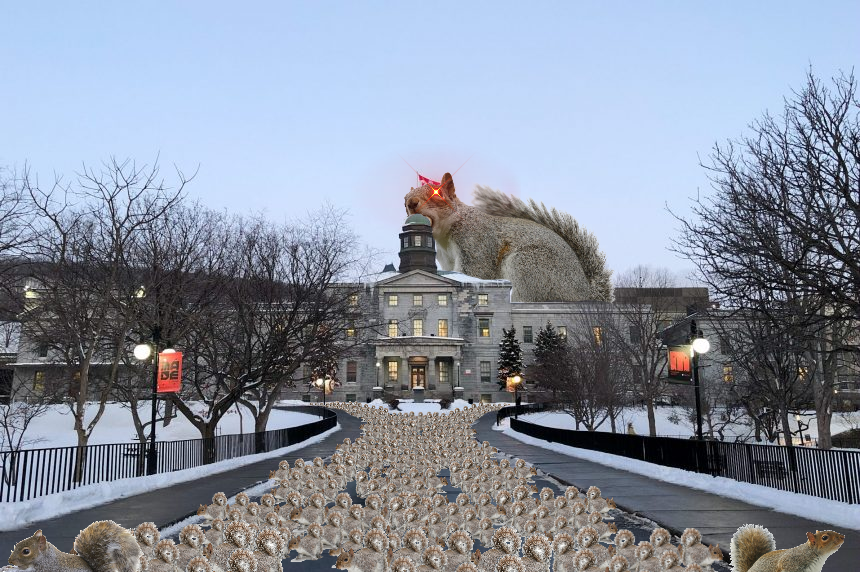Although the eastern grey squirrel (Sciurus carolinensis) is native to eastern North American regions such as Montreal, their adaptive traits allow them to thrive elsewhere, like British Columbia or Europe, where they are categorized as an invasive species. Despite their name, some have dark brown or black coats. But common to each, regardless of colour, is their most notable feature: Big, bushy tails. The etymology of the word “squirrel” comes from the Greek skiouros, from skia, meaning “shadow,” and oura, meaning “tail,” presumably in reference to the shade their fluffy tails cast while they sit with them tucked above their heads.
Do they take a winter break?
Not quite. Eastern grey squirrels do not hibernate in the winter, but they are less active. They bulk up, eating in excess to put on fat in advance of the colder months to weather frigid nights and foraging sessions. In addition, their fur gets thicker and longer, and they may move from summer leaf nests to insulated dens in the hollows of trees.
Chowing down
The eastern grey squirrel has a versatile palate, allowing them to thrive in multiple habitats, including urban ones. As the seasons change, so do their diets. They forage for nuts, seeds, buds, and the flowers of trees, but they are not herbivores, as some might believe—baby birds, eggs, insects and worms are also on the menu. Bird feeders also act as veritable seed buffets, especially in winter when food is scarce. Even as they raid feeders, eastern grey squirrels play an important role in seed dispersal, as they bury more nuts and seeds than they can inevitably eat or recover. Contrary to popular belief, they do not find their stashed goods through memory, but with their highly developed sense of smell.

Squirrely behaviour
It is also the eastern grey squirrel’s sense of smell that allows them to communicate amongst each other, primarily through twitching and chattering noises. Although generally not aggressive, they are territorial, and will alert nearby squirrels if they sense a predator nearby. Since the eastern grey squirrel can travel up to 25 kilometres an hour, they are often spotted whizzing around campus. The flight initiation distance, or distance from which an animal will flee from perceived danger, is shorter with urban squirrels because they are more acclimated to the presence of people and are therefore unafraid to get close to humans if it means snagging a snack.
What about Cloudberry?
Cloudberry is a white squirrel made popular by the McGill Reddit page, where students share photos of sightings. In North America, white squirrels are very rare—but most still count as eastern grey squirrels. There are a few different genetic aberrations that can cause the pale coats. Some white squirrels are albinos, meaning they have a mutation on a gene that codes for pigmentation and thus possess red eyes in addition to pale coats. Others are white morphs, who have a different mutated gene which leads to a partial loss of pigmentation, called leucism. Unlike albinos, they retain their black eyes. Cloudberry is not an albino squirrel, but a leucistic one.
Run, Cloudberry, run
Although leucistic squirrels usually do not survive long in the wild since their white coats make them ultra-visible to predators, many still thrive in urban spaces—and the McGill campus, with its proximity to Mont Royal, green space, and food sources, is no exception. Despite these benefits, the eastern grey squirrel has many defence mechanisms to help protect it from predators. When climbing or descending a tree, they move head first, which allows them to slide inconspicuously around the trunk to keep out of the sight of danger. Alternatively, they can remain motionless against the bark, which makes them difficult to see. Even if a predator catches them, eastern grey squirrels are willing to lose their tail sheath and some vertebrae to escape. For this reason, it is not uncommon to spot a squirrel with only a partial tail.






